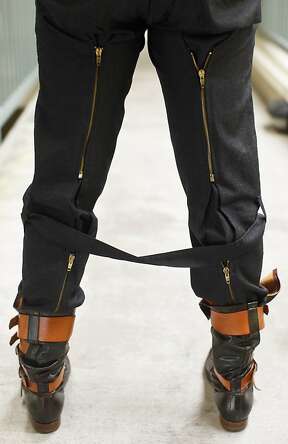Designer and punk rocker a riot of pop culture, with a new album and gig at Academy of Art
April 14, 2013
Fashion designer and punk rocker Keanan Duffty is not as recognizable as some of his collaborators - David Bowie, for instance - but his clothing has been worn by the masses. His apparel has been sold in boutiques and Target department stores. His shoes have encased the feet of Reebok fans. His signature fragrance has perfumed the necks of Aveda devotees.
And now, his hard-edged, antiestablishment music is finding its way to iPods and stereos, wherever similar tastes are found.
Much of his fashion career was spent in New York City, but last fall, he and his filmmaker wife, Nancy Garcia, moved to San Francisco so he could become senior director of fashion merchandising at the Academy of Art University.
He is bringing new energy, projects and industry speakers to the school, and new music to the marketplace with his own new album, "Killers in Glitter." It contains tracks he recorded for the BBC in the 1980s, cover tunes of Bowie and Bauhaus songs, tracks he wrote with Matlock, and other original material.
If his twin loves seem divergent, for Duffty, they're inextricably woven together. Growing up in northern England in the 1960s, he watched "Top of the Pops," a show that brought pop stars of the day to TV screens across the nation. Mark Bolan, Bowie in his Ziggy Stardust phase and glam rockers of the early 1970s were early inspirations. "They looked like they were literally from outer space," he recalled. "I wanted to be like that, but I couldn't, it was so far out of reach."
Then punk was born. "You didn't need to sew to wear the clothes. You could use duct tape," he said. "You didn't need to know how to sing or play a guitar. You could just get up and do it. It was a release for my generation." Duffty also found the androgyny of Patti Smith, Twiggy and Ziggy Stardust appealing. "It has an energy that is potent and confrontational," he said. "Confrontation makes you think."
His love of punk music became a love of punk clothing that morphed into an appreciation for the New Romantic glam rock revival in the 1980s while he was in college. In the years after graduation he formed his own label, designed the England's Dreaming collaboration with Bowie for Target, made leather sneakers with embroidered British heraldic imagery and cityscapes for Reebok, and designed a "natural"-smelling scent for Aveda in Day-Glo pink and yellow packaging.
He designed clothing for a recent Sex Pistols reunion tour and recently became global creative director for the irreverent Moods of Norway clothing brand, whose motto is "Dressing the world, one pink suit at a time."
Among Keanan Duffty's fashion icons are Alexander McQueen and Anthony Price.
Speaking of colors, Duffty's hair is short, spiky and blond at the moment. But don't take it as a sign of conformity, or old age. "I might dye it red again," he said with a laugh. "I've not given up - I'm a regressive adolescent at heart."
On the bondage pants he's wearing: They were based on a postal carrier's bag. Malcolm McLaren came up with the idea of making trousers you couldn't walk in. He had the ideas, and (his girlfriend) Vivienne Westwood would make it happen. How do I feel in them? Restricted!
The zipper runs all the way from the fly in front underneath and around to the back. I wore them to my wedding. Nancy Garcia, my wife, won a competition with an essay, and the prize was to be married on the top of the Empire State Building on Valentine's Day. She wore a Helmut Lang dress of ribbons. I thought the only thing to do was to wear the item of clothing that was symbolic to me, both confrontational and memorable.
On his personal aesthetic: It's all about pop culture. It has been that way since I was 9.
On what he wore as a teen: There were two sides of my teen years: punk, when I made T-shirts out of trash bags and tape and wore red vinyl, super-skinny pants and pointy shoes; and then, at 16, in 1980, the New Romantic thing started, so I had a chance to do glam rock. I dyed my long hair red and blond and wore makeup.
In college, I went on a bus in tottery heels or platform sneakers. Anything Westwood and McLaren were making was appealing. It was the era of Annie Lennox and Boy George. You could get away with anything.

Russell Yip, The Chronicle
Fashion designer and punk rock musician Keanan Duffty wears his Vivienne Westwood bondage pants, which he also wore on his wedding day.
On his fashion icons: Anthony Price designed clothes for Roxy Music. They looked like they were 1950s doo-wop aliens. Japanese designer Kansai Yamamoto, who designed kimonos for Bowie's Ziggy Stardust phase. Alexander McQueen.
On what he wouldn't be caught dead in: The red velvet suit I wore in 1980 when I was 16, which was featured on the cover of "New Romantics: The Look," by Dave Rimmer in 2003. But only because I don't fit in it anymore.
On his fashion pet peeve: Good taste. It's the most boring thing. It shows a lack of imagination. People defer to good taste because they can't make up their own mind.
On why he's releasing a new album now: Because I thought it would be fun.
Carolyne Zinko is a San Francisco Chronicle staff writer. E-mail: czinko@sfchronicle.com Twitter: @carolynezinko


No comments:
Post a Comment